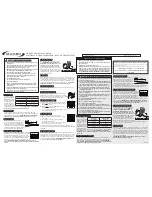
Page 40
PSI 9000 2U Series
EA Elektro-Automatik GmbH
Helmholtzstr. 31-33 • 41747 Viersen
Germany
Fon: +49 2162 / 3785-0
Fax: +49 2162 / 16230
3.
Operation and application
3.1
Personal safety
•
In order to guarantee safety when using the device, it is essential that only persons operate
the device who are fully acquainted and trained in the required safety measures to be taken
when working with dangerous electrical voltages
•
For models which can generate a voltage which is dangerous by contact, or is connected to
such, the included DC terminal cover, or an equivalent, must always be used
•
Whenever the load and DC output are being re-configured, the device should be disconnected
from the mains, not only the DC output switched off!
3.2
Operating modes
A power supply is internally controlled by different control or regulation circuits, which shall bring voltage, current
and power to the adjusted values and hold them constant, if possible. These circuits follow typical laws of control
systems engineering, resulting in different operating modes. Every operating mode has its own characteristics
which is explained below in short form.
3.2.1 Voltage regulation / Constant voltage
Voltage regulation is also called constant voltage operation (CV).
The DC output voltage of a power supply is held constant on the adjusted value, unless the output current or the
output power according to P = U
OUT
* I
OUT
reaches the adjusted current or power limit. In both cases the device
will automatically change to constant current or constant power operation, whatever occurs first. Then the output
voltage can not be held constant anymore and will sink to a value resulting from Ohm’s law.
While the DC output is switched on and constant voltage mode is active, then the condition “CV mode active” will
be indicated on the graphic display by the abbreviation CV and this message will be passed as a signal to the
analog interface, as well stored as status which can also be read as a status message via digital interface.
3.2.1.1 Speed of the voltage controller
The internal voltage controller can be switched between “slow” and “fast” (see
„3.3.3.1. Menu “General Settings”“).
Factory default value is “slow”. Which setting to select depends on the actual situation in which the device is going
to be operated, but primarily it depends of the type of load. An active, regulated sink such as an electronic load
has its own voltage control circuit which works concurrently to the power supply’s circuit. Both might work against
each other and lead to oscillation. If this occurs it is recommended to set the controller speed to “slow”.
In other situations, e.g. operating the function generator and applying various functions to the DC output values of
the power supply and setting of small time increments, it might be necessary to set the voltage controller to “fast”
in order to achieve the expected results.
3.2.2 Current regulation / constant current / current limiting
Current regulation is also known as current limitation or constant current mode (CC).
The DC output current is held constant by the power supply, once the output current to the load reaches the adjusted
limit. Then the power supply automatically switches The current flowing from the power supply is determined by the
output voltage and the load’s true resistance. As long as the output current is lower than the adjusted current limit,
the device will be either in constant voltage or constant power mode. If, however, the power consumption reaches
the set maximum power value, the device will switch automatically to power limiting and sets the output current
according to I
MAX
= P
SET
/ U
IN
, even if the maximum current value is higher. The current set value, as determined
by the user, is always an upper limit only.
While the DC output is switched on and constant current mode is active, then the condition “CC mode active” will
be indicated on the graphic display by the abbreviation CC and this message will be passed as a signal to the
analog interface, as well stored as status which can also be read as a status message via digital interface.
















































